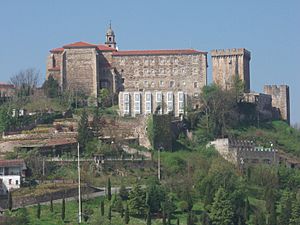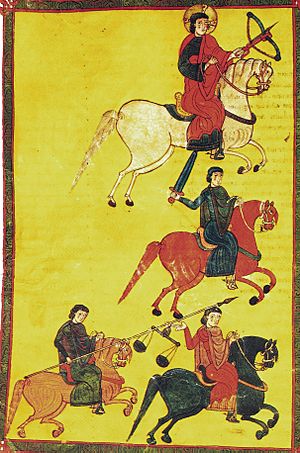Fruela Díaz facts for kids
Fruela Díaz (died 1119), also known as Froila Díaz, was an important nobleman in the Kingdom of León in Spain. He was a very powerful figure during the later years of King Alfonso VI and the early rule of Queen Urraca.
Fruela was a very wealthy man who bought many lands to make his properties even bigger. He was important enough to marry into a royal family. He also got along well with the rulers of León, Galicia, and Portugal. These areas were just west of his main lands. Fruela also started a hospital, an inn for travelers, and a new town. His lands were famous for raising some of the best horses in Spain. When he died, he was buried in the royal burial place of the kings of León. His high rank, which was second only to the king and the rulers of Galicia and Portugal, is even mentioned in a famous old Spanish poem called cantares de gesta.
Contents
Fruela's Family and Early Life
Fruela came from the Asturias region of Spain. While his parents are not clearly named in all old records, it is believed his father was Diego Pérez and his mother was Mayor (María) Fróilaz. An old document from 1078 mentions Mayor Fróilaz and her sons, Fruela Díaz and Antonio Díaz, confirming their family line.
Fruela's older brother, Antonio, died young. This meant Fruela became the only son and inherited all of his father's lands. The family records of Fruela's branch of the Flagínez family were kept safe in a monastery. This is very rare for noble families from that time in Spain.
Serving Raymond of Galicia
Fruela worked for Count Raymond of Galicia as his majordomo (say: mah-jor-DOH-moh). This was the highest official in Raymond's court, like a chief of staff. He held this important job from at least 1094 to 1096, and possibly even longer.
Fruela often traveled with Count Raymond around Galicia. He openly supported Raymond in his disagreements with the king. Even so, Fruela was also important at the royal court. He signed off on many of the king's official documents during the later part of Alfonso VI's rule.
Lands and Titles from the Crown
Both of Fruela's grandfathers were counts, which was a high noble rank. By May 1087, Fruela himself also held the title of count. Soon after, in 1091, he was given control of the area called Valdeorras in Galicia. This type of land was called a fief (say: feef) or tenencia. It meant he governed the land for the king and the king could take it back at any time. This was different from his own private lands, which he owned outright.
Fruela also governed other important areas for the king. These included Sarria (1098–1103), Larín (1102–06), and the important city of Astorga (1107–17). He is most often linked with Astorga after 1107. Governing Astorga meant he had power in the city's surrounding region.
In 1104, Fruela and his wife started a new settlement at the base of a castle called castro Dactonio. This settlement grew into the town of Monforte de Lemos. Fruela governed this town until 1111.
Later in his life, Fruela briefly governed other areas like Aguilar (1111–12) and Cifuentes de Rueda (1117–19). He also governed the Bierzo region around 1115. In 1116, he gave land in the mountains of Puerto de Pajares to a church. This land was used to build a hostel, which is like an inn, for travelers. This hostel helped people traveling through the mountains until 1835.
Marriage and Personal Business
Fruela married Estefanía Sánchez around 1085. She was from a royal family, being the daughter of Sancho Garcés, an illegitimate son of King García Sánchez III of Navarre. Estefanía owned lands near Calahorra. She might have sold these lands to buy property closer to her husband's estates.
On March 1, 1112, Fruela and Estefanía received a gift of land in Astorga from Henry of Portugal. This gift included a tower and part of the city wall. Estefanía lived at least ten years longer than Fruela. In 1129, she granted a fuero (a special set of laws or rights) to the town of Villarmildo. Fruela and Estefanía had four children: Constance, Diego, María, and Ramiro.
Fruela and Estefanía were very active in buying new properties between 1088 and 1113. There are records of twenty-three such deals, which is a lot for that time. Buying land, especially by nobles from peasants, became very common in Spain during this period.
In 1118, a man named Martín Eitaz was found guilty of killing one of Fruela's servants. As punishment, he had to become Fruela's servant for life, unless he paid a large sum of money.
Working for Queen Urraca
Fruela was one of the important nobles who witnessed Queen Urraca's first official act in July 1109. By doing so, he showed he accepted her claim to have been given "the whole kingdom" by her father, King Alfonso VI. In this document, Fruela signed as legionensium comes, which means "count of León." This was a very important title.
In 1112, Queen Urraca gave Fruela some estates as a "gift" for his "loyal service." Fruela returned her kindness by giving her a magnificent horse. This horse was worth 5,000 solidi, which was a huge amount of money at the time, equal to 5,000 sheep! A horse worth so much would surely be for the queen herself. This shows how incredibly wealthy Fruela was.
In 1115, when Queen Urraca and her husband, Alfonso the Battler, King of Aragon, were fighting for control of an important monastery, Fruela was acting as count in a nearby area. In December 1117, Fruela also witnessed a document from Urraca's son, Alfonso Raimúndez. The people of Galicia had made Alfonso Raimúndez a co-ruler with his mother in 1111, even though she didn't want him to be.
Death and Legacy

Fruela died in the summer of 1119. He passed on his lands in Cifuentes to his oldest son, Diego. Diego later became a high official for King Alfonso VII but died young in 1040. Diego's daughter, Estefanía Díaz, was disinherited by her uncle Ramiro when she married without his permission. Ramiro then received Cifuentes. The town of Cifuentes later received its own special laws (a fuero) from Ramiro's son.
Fruela's older daughter, Constance, died when she was young. His younger daughter, María, married twice.
Fruela and Estefanía may have been buried in the Panteón de los Reyes (Royal Pantheon) in the church of San Isidoro de León. This was a burial place for their relatives from the Flagínez family. Some historians claimed to have found their tombs there, but the inscriptions on the tombs are now unreadable, so it's hard to be sure.
Fruela's importance after his death can be seen in a famous old Spanish poem called the Poema del Cid, written around 1140. In the poem, Fruela is mentioned as a very important nobleman, just below King Alfonso VI, Henry of Portugal, and Raymond of Galicia. This shows how respected he was for his long career serving these powerful rulers.
See also
 In Spanish: Fruela Díaz para niños
In Spanish: Fruela Díaz para niños




